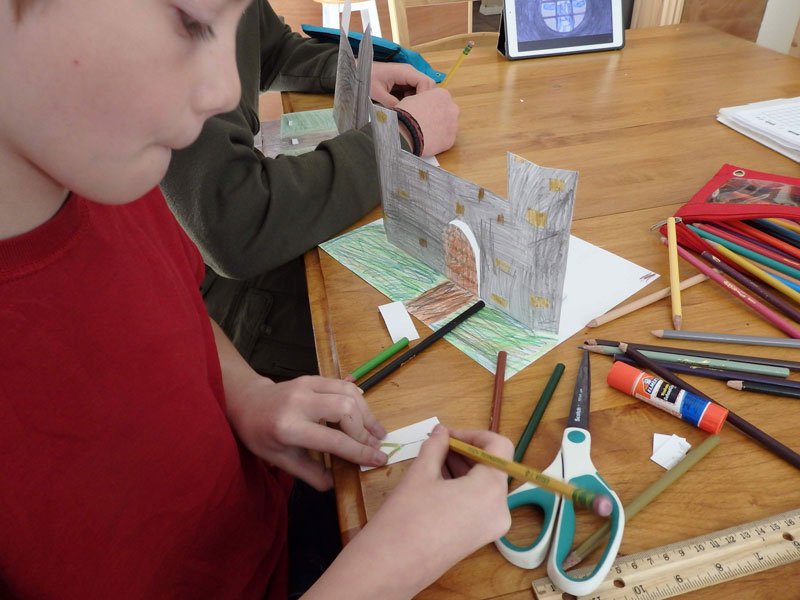You’ve been using Layers of Learning for awhile now and you realize you need to assign grades. How do you go about evaluating work in an experienced based curriculum that includes no tests and is for multiple ages?
Evaluations include tests, writing assignments, and projects. You can give grades for these things, or not. It’s up to you. We’ll walk you through how to create your own evaluations.
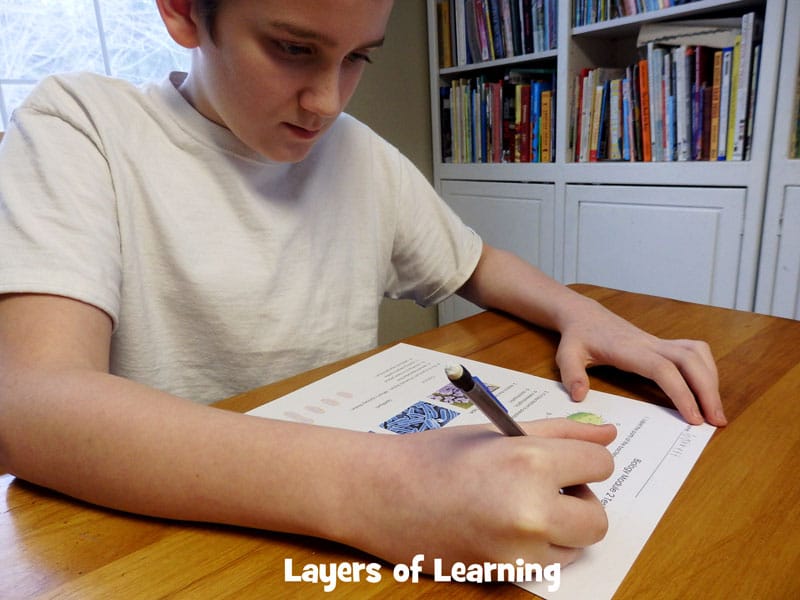
Do You Need to Evaluate?
You don’t necessarily need to evaluate your student’s work. It’s important to understand the reasons for taking tests and giving grades so you can decide if you need them.
Here’s why kids should take tests or get grades
- Tests help kids put mental effort into remembering facts.
- Tests make for an excellent review and a chance to brush up on things not absorbed.
- Grades help kids understand where they are falling short so they can rectify gaps in understanding or skills and, at the same time, it motivates them to do better.
- Tests are good practice for test taking later in life, when they return to school, get a drivers licence, take a college entrance exam, and so on.
- In some cases, grades are required by your government or school.
- Your child is in high school. All high school age kids (14-18) need formal grades because you need to be able to create a transcript, whether your child is college bound or not, the transcript is the only official documentation of a home schooled child’s work. Read more about grades and transcripts for high school. You can also get a pre-formatted spreadsheet for grade and transcript tracking.
-
 Gradebook$14.99
Gradebook$14.99
But young kids, 9 years old and younger, really don’t need tests or grades at all. And you do not need to test for every topic of every subject all of the time. But if you do give tests, keep in mind your purpose so the tests you give are designed to achieve those purposes.
First, Tests
We do not provide tests as a built-in feature of Layers of Learning because every family who uses the curriculum is learning different things. If we added in pre-written tests, it would force you to teach to the test. We don’t think the exact experiments you do or facts you learn about trees, for example, are that important. The important thing is exploring the world and expanding your horizons.
There isn’t a single set of facts that everyone must know. So we don’t include tests with any of our curriculum materials. We also feel that testing on every subject all the time is not necessary. Do you really need a test after going on an imaginary tour of France?
Making Your Own Tests
With that said, testing can be a valuable learning tool. So, if you do want to create a test for a particular subject you have been learning about, keep track of the major facts you come across as you read and learn. Then just write up a series of questions, multiple choice, matching, or open ended and give your kids the test.
Here are some more creative ways to do “testing”.
- Play Jeopardy
- Go Fishing
- Play matching games or trivia games
- Have a discussion during which you verbally “quiz” your child in an informal way on what he or she learned.
- Keep a Big Book of Knowledge and play review games.
Testing Multiple Ages At Once
Layers of Learning is a family style curriculum so there’s a good chance you have more than one age of child being tested. There are a couple of ways to handle this.
- Write different tests for the different ages of children.
- Have them all take the same test and give automatic bonus points to younger kids (decide which questions will be bonus and not required for younger ones or just give them automatic extra points).
- Give the test only to your older children and let the younger ones off the hook completely.
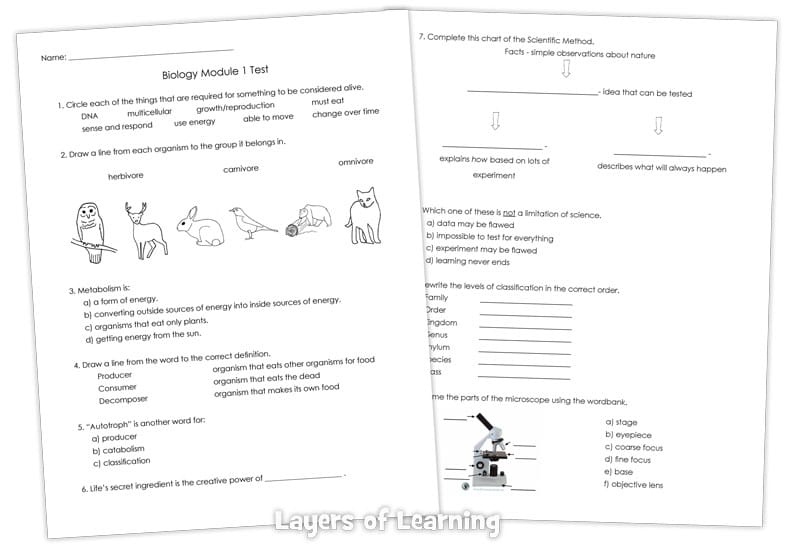
The biology test above was given to three of my children: 11, 13, and 15 years old. All four of my children, including my 9 year old participated in the learning but the youngest was not required to take the test. On that particular test, my 11-year-old actually got the best grade because we were learning all together and age wasn’t important. You know your kids best so make your testing decisions based on their needs and abilities.
Evaluate the Evaluation
What if you gave a test and one or more of your children bombed it? Or what if you realized the tests are giving your children anxiety, making them hate learning, or harming in some other way.
You can re-give a test after more studying, you can throw one out, or you can re-think your whole testing strategy. If you gave a test, it is not set in stone. You are the teacher, you decide the grading criteria, and you decide the test contents. Go back to the reasons for giving tests and decide if the reasons are compelling enough to work through the anxiety or whatever.
Go over every test with your children, talk about the answers they missed, and make sure the tests are learning tools as well as testing tools.
Second, Writing Assignments
Writing assignments are a great way to evaluate how much your kids have learned. Writing also helps kids process and analyze what they’ve learned. It creates a thought response.
The sidebars of Layers of Learning units have ideas for creative and expository writing assignment that go with topics in the units. You can also peruse our Writer’s Workshop Page for more ideas.
All writing should always be evaluated. This may just be applauding after an oral presentation is given, verbal feedback, a written note on the page, or a more formal grade. Whatever the case, feedback tells your kids you value their work and allows for growth. If you do assign grades, the grade can be given in the Layers of Learning subject the writing was about or as a “Language Arts” grade.
Inside the Layers of Learning Homeschool Planner we have included Writer’s Workshop pages that give writing ideas, skills to develop, and help in planning a writing project. You can read more about how to use that part of the planner in our How to Plan a Writer’s Workshop Unit.
How to Grade Writing
Grading written work and papers can be the most difficult and subjective of all grades. Karen has a system for grading writing that is explained in the Writer’s Workshop Guidebook and can be used with any kind of writing in any subject. It makes assigning the grade much easier and it makes the feedback you give your child useful in their quest to improve their writing.
Third, Projects
You may also want to grade things like a poster, a map, a diorama, a video presentation, or an experiment completed by your child. Do it the same way you grade a writing project, with similar criteria. Include things like this.
- Direction following
- Neatness
- Thorough information (according to their age and the assignment)
- Presentation (if they are presenting it aloud in front of a group)
- Mechanics (complete sentences, spelling, punctuation, all according to the assignment)
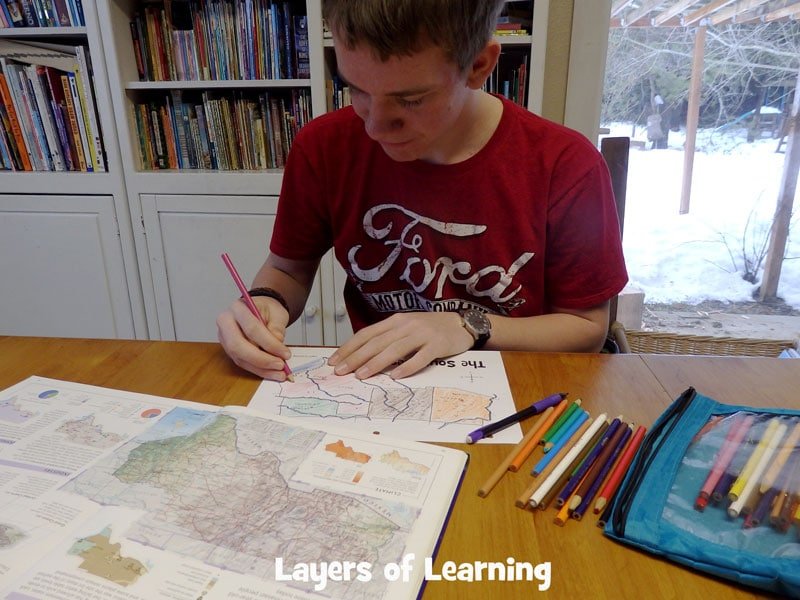
Finally, Putting Together a Grade
Inside the Layers of Learning Homeschool Planner there are sheets for grades. Label the top of the grade column with the class, “History”, for example. Along the left side list the assignments. Next to each assignment enter a grade in percentage form. If you always use percentages instead of points then assignments can vary in points without skewing your grades. At the end of the school term add up the percentages and then divide by the number of assignments.
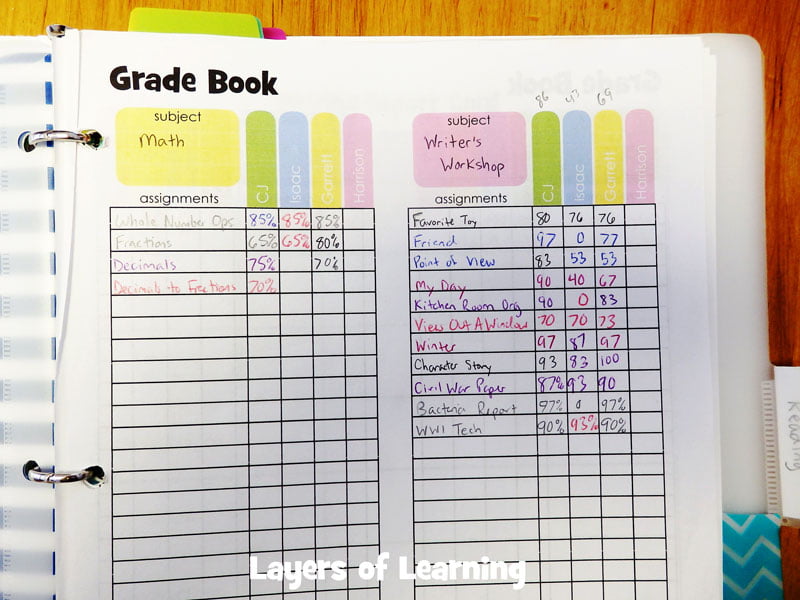
You can also give percentages based on participation or attendance. Lots of teachers do this and it help to boost the grades. It’s also valid because not everything your child learned during the course was tested or graded, so this covers the rest of it. For example, maybe you decide half the grade will be for participation. So you take your already figured percentage for work completed and add it to your 100% participation grade and then divide by two, for the two parts of the grade.
We give a thorough explanation of grading diverse classes in our article How to Track Grades and Transcripts.
Summary of Grades
So if you decide you do want to give a grade for a class here is how.
- Create tests with info you actually learned and you think your child should remember.
- For projects and writing assignments create rubrics that define the criteria for the grade and use it when assigning a grade.
- Record all grades as percentages for each individual class.
- Average the percentages and include a participation portion of the grade if you like.
Get a Free Unit
Choose between the first unit in each Layers of Learning subject to try for free when you sign up for the newsletter.
We never spam and you can cancel your subscription at any time.


